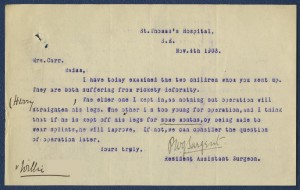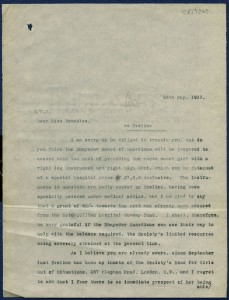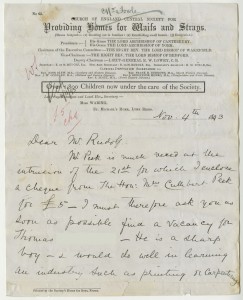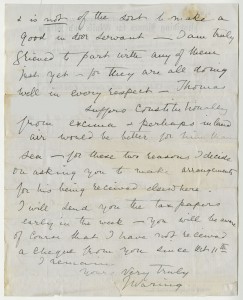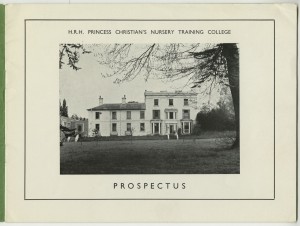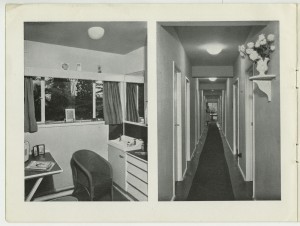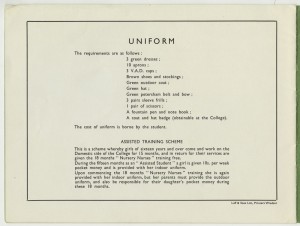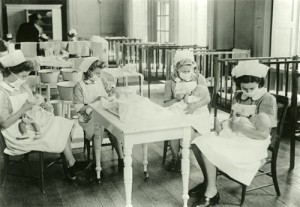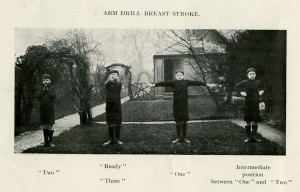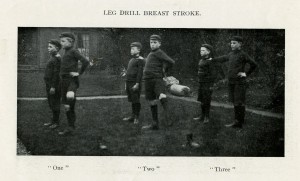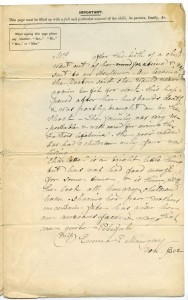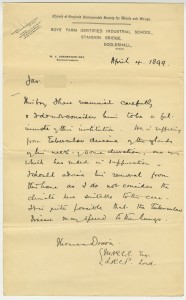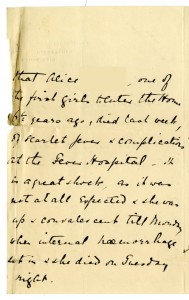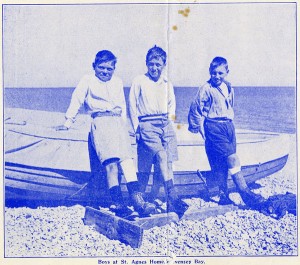It’s easy to forget that the past not only looked different to the present, it tasted different too. In today’s post we’ll take a look at some dietary diaries to see how people’s diets have changed over the past 60 years.
A lot of The Children’s Society’s children’s homes started keeping dietary diaries in the mid-20th Century. These diaries list the food that was fed to the children in the homes each day and so are a great resource for studying diet. (As long as you don’t study them on an empty stomach, that is, otherwise you may find yourself daydreaming about food rather than working, as I have found out to my own embarrassment!)
The first dietary diary I’m going to share with you today comes from St Agatha’s Home for Girls in Princes Risborough, Buckinghamshire, and dates from 1955.
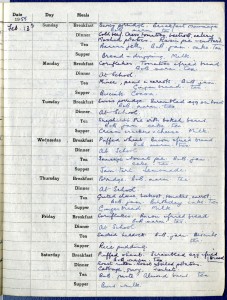
1955 Feb. 13th
Sunday
Breakfast – Swiss porridge. Breakfast sausage B&B marm. tea.
Dinner – Cold beef. Cress tomatoes. beetroot. celery Mashed potatoes. Raisin pie – custard
Tea – Banana jelly. B&B. jam. cake. Tea.
Supper – Bread & dripping. Milk.
Monday
Breakfast – Cornflakes. Tomatoes & fried bread. B&B. marm. Tea.
Dinner – At School.
Tea – Mince, peas and carrots. B&B. jam. Gingerbread. tea.
Supper – Biscuits. Cocoa.
Tuesday
Breakfast – Swiss porridge. Scrambled egg on toast B&B. marm. tea.
Dinner – At School.
Tea – Shepherd’s Pie with baked beans. B&B. jam. cake. tea.
Supper – Cream crackers & cheese. Milk.
Wednesday
Breakfast – Puffed wheat. Bacon & fried bread. B&B. marm. tea.
Dinner – At School
Tea – Sausage & tomato pie. B&B. jam. cake. Tea.
Supper – Jam tart. Lemonade.
Thursday
Breakfast – Porridge. B&B. marm. tea.
Dinner – At School.
Tea – Grated cheese. beetroot. tomatoes. carrot. B&B. Jam. Birthday cake. Tea.
Supper – Gingerbread. Milk.
Friday
Breakfast – Cornflakes. Bacon & fried bread. B&B. marm. tea.
Dinner – At School.
Tea – Smoked haddock. B&B. jam. Biscuits tea.
Supper – Rice pudding.
Saturday
Breakfast – Puffed wheat. Scrambled egg & fried Bread B&B. marm. Tea.
Dinner – Roast mutton. Roast & boiled potatoes. Cabbage. gravy. Junket.
Tea – B&B. paste. Almond buns. Tea.
Supper – Buns & milk.
A lot of this food may seem rather conservative now: cooked breakfasts and fish on Fridays, all eaten with lots of bread and butter. However, this was a time when food rationing had just ended in the UK so you can imagine that many of the items here, like banana jelly, would have been quite exciting for the children eating them.
There doesn’t seem to be much processed food in this diet, with the notable exceptions being breakfast cereals, paste, baked beans and cream crackers. It’s also to interesting to note just how much tea the children were drinking, which is not necessarily a drink we associate with children these days.
And if anyone has eaten Swiss porridge or junket, I’d love it if you could tell me a bit more about them in the comments!
The next diary we have comes from the Harvey Goodwin Home in Cambridge and dates from 1971.
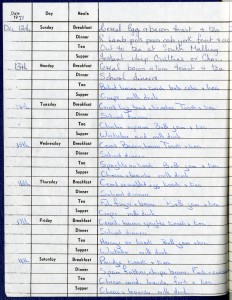
1971 Dec 12th
Sunday
Breakfast – Cereal Egg & bacon toast, & tea
Dinner – R. Lamb pots peas cab York, fruit & cus
Tea – Out to tea at South Malling
Supper – Instant whip Ovaltine or Choc.
13th
Monday
Breakfast – Cereal bacon & tom toast & tea
Dinner – School dinners
Tea – Baked beans on toast b&b cake & tea.
Supper – Crisps milk drink
14th
Tuesday
Breakfast – Cereal Egg bread & tomatoes. Toast & tea
Dinner – School dinners.
Tea – Chicken supreme. B&B jam & tea.
Supper – Weetabix and milk drink.
15th
Wednesday
Breakfast – Cereal. Bacon, beans Toast & tea.
Dinner – School dinners.
Tea – Spaghti on toast. B&B jam & tea.
Supper – Cheese & biscuits milk drink.
16th
Thursday
Breakfast – Cereal scrambled egg toast & tea.
Dinner – School dinners.
Tea – Fish finger & beans. B&B jam & tea
Supper – Crisps milk drink.
17th
Friday
Breakfast – Cereal. bacon spaghti toast & tea.
Dinner – School dinners.
Tea – Herrings on toast B&B jam & tea.
Supper – Weetabix milk drink.
18th
Saturday
Breakfast – Porridge toast & tea
Dinner – Spam fritters, chips. beans. Fruit & custard
Tea – Cheese sand. biscuits, fruit & tea.
Supper – Cheese & biscuits milk drink.
In this diet we begin to see the rise of processed foods: fish fingers, spaghetti on toast, crisps, instant whip and Ovaltine. Baked beans and breakfast cereals also seem to be eaten with more frequency than they were a decade and a half before.
And then there are some foods that seem to be very much of their time, such as chicken supreme and spam fritters! Do you remember those?
That said, there are similarities with the previous diet. A lot of bread and butter is being eaten and a lot of tea is being drunk; roast meals are a weekly occurrence; fish is eaten on a Friday; and there is always a cooked element to breakfast.
Our last diet dates from 1991 and comes from the Pimlico Road Home in Clitheroe, Lancashire.
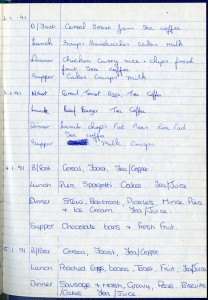
2.1.91 [Wednesday]
B/Fast – Cereal Toast Jam Tea coffee.
Lunch – Soup & Sandwiches cakes. milk.
Dinner – Chicken Curry rice & chips fresh. Fruit Tea coffee.
Supper – Cakes Crisps Milk
3.1.91 [Thursday]
B/Fast – Cereal. Toast. Eggs, Tea Coffee
Lunch – Beef Burger Tea Coffee.
Dinner – Lamb chop’s Pot Pea’s Rice Pud. Tea coffee.
Supper – Milk. Crisps
4.1.91 [Friday]
B/Fast – Cereal, Toast, Tea/Coffee.
Lunch – Pies. Spagetti. Cakes. Tea/Juice.
Dinner – Stew, Beetroot, Pickles, Mince Pies & Ice Cream. Tea/Juice.
Supper – Chocolate bars & fresh fruit.
5.1.91 [Saturday]
B/Fast – Cereal, Toast, Tea/Coffee.
Lunch – Poached Eggs, beans, Toast, Fruit, Tea/Juice
Dinner – Sausage & Mash, Gravy, Peas. Biscuits/Cakes. Tea/Juice.
You might notice that by this time the standard printed dietary diary books have gone and that the staff have had to draw up their own book. This means that we can now see a difference in the names of the meals; ‘tea’ is gone and ‘lunch’ has suddenly appeared, pushing ‘dinner’ into the slot that ‘tea’ used to take. Of course, the names of meals can differ by place as well as by time, so there’s nothing to say that these names were in country-wide use in the 1990s.
As for this diet, we can see some less traditional food creeping in, such as curry and rice. Beef burgers are also present while a cooked breakfast in the morning and the ubiquitous bread and butter are almost completely lost. The availability of coffee in the morning is interesting, but this may be down to the age of the children in the home rather than the decade.
All in all, though, there is not too much to separate this diet from the diets of the 1970s and 1950s. Main meals are often made up of ‘meat and two veg’; tea is given to the children throughout the day; and supper is regularly made up of something sweet and a milky drink. It would be interesting to know what this sort of diary would say today. Do these diets represent how the population ate as a whole or were the meals cooked in residential homes slightly different to those eaten in other households?
A point we mustn’t forget is that diet can vary by region and by age as well as by the time-period, so it’s not possible to conclude that the differences between these three diets are based on the decade alone. It would be worthwhile, therefore, to take diaries from the same year for several different homes and see if there was much variation between them.
That’s a potential project for the future, though. Right now, I’ve managed to make myself hungry again! (Oh dear.)
If you’d like to share your experiences of any of these foods in the comments, then please do. Or perhaps you know some other foods that bring back memories of a certain era. Arctic Roll, anyone?

